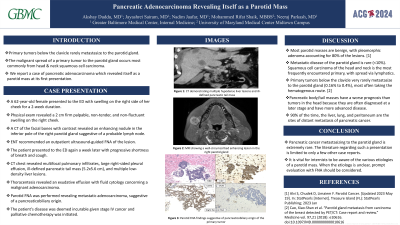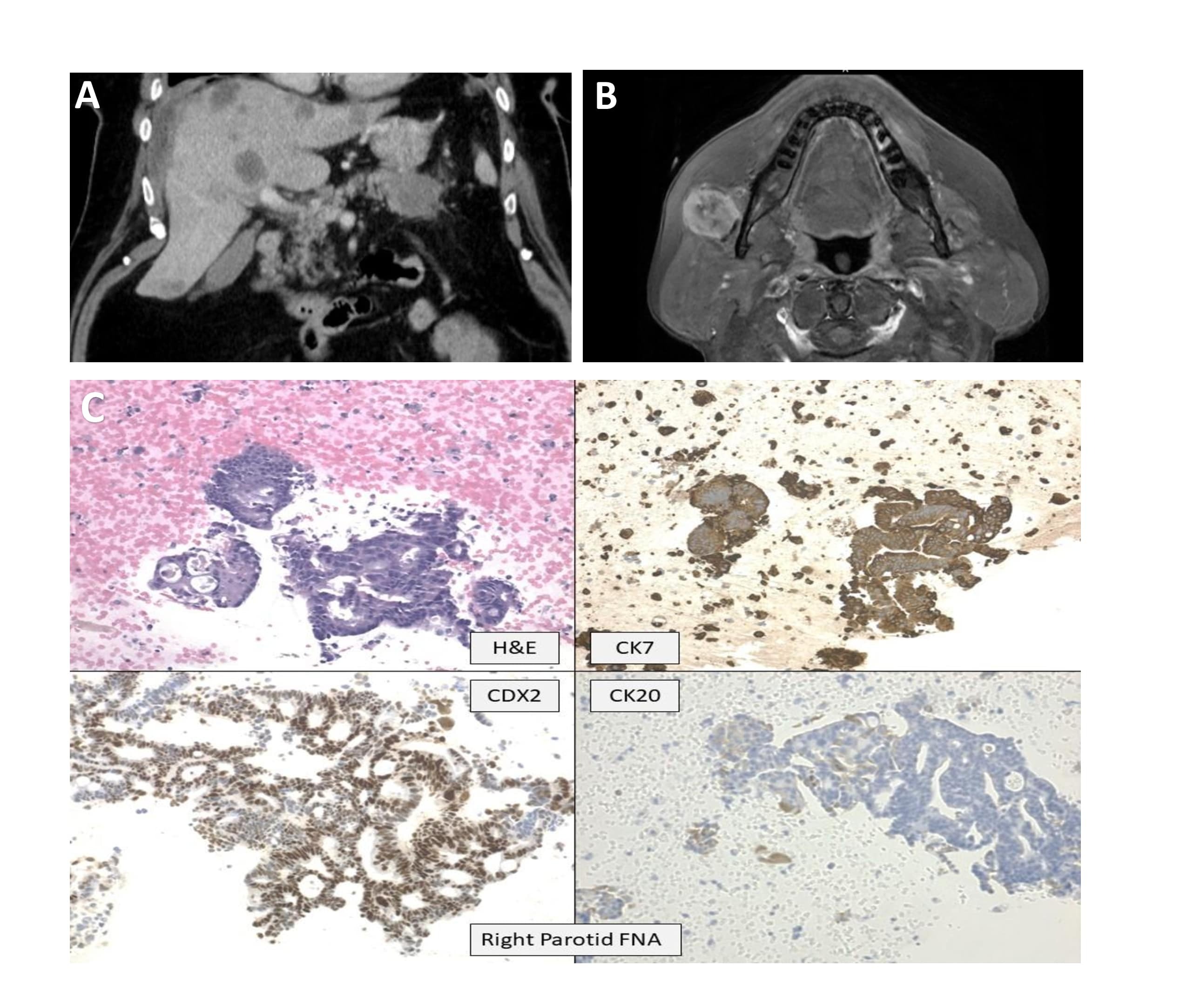Tuesday Poster Session
Category: Biliary/Pancreas
P3561 - Pancreatic Adenocarcinoma Revealing Itself as a Parotid Mass
Tuesday, October 29, 2024
10:30 AM - 4:00 PM ET
Location: Exhibit Hall E

Has Audio

Akshay Duddu, MD
Greater Baltimore Medical Center
Towson, MD
Presenting Author(s)
Akshay Duddu, MD1, Jayashrei Sairam, MD1, Nadim Jaafar, MD1, Mohammed Rifat Shaik, MBBS2, Neeraj Parkash, MD1
1Greater Baltimore Medical Center, Towson, MD; 2University of Maryland Medical Center Midtown Campus, Baltimore, MD
Introduction: Pancreatic cancer is the fourth leading cause of cancer deaths in the United States (US). Painless jaundice, abdominal pain, and weight loss are the three common presentations of pancreatic cancer. Here, we present a rare case of pancreatic tail adenocarcinoma initially presenting as a parotid mass.
Case Description/Methods: A 62-year-old lady presented to the emergency department (ED) with swelling on the right side of her cheek for 2 weeks. Examination revealed a 2 cm firm palpable area of swelling of the right cheek with no tenderness, fluctuance, or surrounding induration. A CT of the facial bones with contrast revealed an enhancing nodule in the inferior pole of the right parotid gland suggestive of a probable lymph node. The patient was discharged from the ED to follow up with ENT for an ultrasound-guided FNA of the parotid lesion. A week later, the patient returned to the ED with progressive shortness of breath and cough. CT chest with contrast revealed multifocal infiltrates, large right-sided effusion, ill-defined pancreatic body/tail mass measuring 5.2 x 5.6 cm, and multiple low-density lesions in the liver concerning metastatic disease. The patient was admitted for an expedited workup. Diagnostic thoracentesis revealed an exudative effusion and fluid cytology concerning a malignant adenocarcinoma. A parotid FNA was performed which returned positive for metastatic adenocarcinoma of the pancreas. Given the stage IV cancer, the patient's disease was deemed incurable, and palliative chemotherapy with cisplatin and gemcitabine was initiated.
Discussion: Pancreatic cancers account for about 3% of all cancers in the US with pancreatic adenocarcinoma being the predominant variant. It is considered a lethal diagnosis with a 5-year survival rate of approximately 6%. Pancreatic body/tail masses have a worse prognosis than tumors in the head because they are often diagnosed at a later stage and have more advanced disease. 90% of the time, the liver, lung, and peritoneum are the sites of distant metastases. We present an exceptionally rare case of a metastatic parotid mass as the initial presentation of pancreatic adenocarcinoma. The literature regarding such a presentation is limited to only a few other case reports. This case also highlights an uncommon presentation of a parotid mass, as primary tumors arising below the clavicle very rarely metastasize to the parotid gland (0.16% to 0.4%).

Disclosures:
Akshay Duddu, MD1, Jayashrei Sairam, MD1, Nadim Jaafar, MD1, Mohammed Rifat Shaik, MBBS2, Neeraj Parkash, MD1. P3561 - Pancreatic Adenocarcinoma Revealing Itself as a Parotid Mass, ACG 2024 Annual Scientific Meeting Abstracts. Philadelphia, PA: American College of Gastroenterology.
1Greater Baltimore Medical Center, Towson, MD; 2University of Maryland Medical Center Midtown Campus, Baltimore, MD
Introduction: Pancreatic cancer is the fourth leading cause of cancer deaths in the United States (US). Painless jaundice, abdominal pain, and weight loss are the three common presentations of pancreatic cancer. Here, we present a rare case of pancreatic tail adenocarcinoma initially presenting as a parotid mass.
Case Description/Methods: A 62-year-old lady presented to the emergency department (ED) with swelling on the right side of her cheek for 2 weeks. Examination revealed a 2 cm firm palpable area of swelling of the right cheek with no tenderness, fluctuance, or surrounding induration. A CT of the facial bones with contrast revealed an enhancing nodule in the inferior pole of the right parotid gland suggestive of a probable lymph node. The patient was discharged from the ED to follow up with ENT for an ultrasound-guided FNA of the parotid lesion. A week later, the patient returned to the ED with progressive shortness of breath and cough. CT chest with contrast revealed multifocal infiltrates, large right-sided effusion, ill-defined pancreatic body/tail mass measuring 5.2 x 5.6 cm, and multiple low-density lesions in the liver concerning metastatic disease. The patient was admitted for an expedited workup. Diagnostic thoracentesis revealed an exudative effusion and fluid cytology concerning a malignant adenocarcinoma. A parotid FNA was performed which returned positive for metastatic adenocarcinoma of the pancreas. Given the stage IV cancer, the patient's disease was deemed incurable, and palliative chemotherapy with cisplatin and gemcitabine was initiated.
Discussion: Pancreatic cancers account for about 3% of all cancers in the US with pancreatic adenocarcinoma being the predominant variant. It is considered a lethal diagnosis with a 5-year survival rate of approximately 6%. Pancreatic body/tail masses have a worse prognosis than tumors in the head because they are often diagnosed at a later stage and have more advanced disease. 90% of the time, the liver, lung, and peritoneum are the sites of distant metastases. We present an exceptionally rare case of a metastatic parotid mass as the initial presentation of pancreatic adenocarcinoma. The literature regarding such a presentation is limited to only a few other case reports. This case also highlights an uncommon presentation of a parotid mass, as primary tumors arising below the clavicle very rarely metastasize to the parotid gland (0.16% to 0.4%).

Figure: Fig A: CT demonstrating multiple hypodense liver lesions and ill-defined pancreatic tail mass
Fig B: MRI showing a well-circumscribed enhancing lesion in the right parotid gland
Fig C: Parotid FNA findings suggestive of a pancreaticobiliary origin of the primary tumor
Fig B: MRI showing a well-circumscribed enhancing lesion in the right parotid gland
Fig C: Parotid FNA findings suggestive of a pancreaticobiliary origin of the primary tumor
Disclosures:
Akshay Duddu indicated no relevant financial relationships.
Jayashrei Sairam indicated no relevant financial relationships.
Nadim Jaafar indicated no relevant financial relationships.
Mohammed Rifat Shaik indicated no relevant financial relationships.
Neeraj Parkash indicated no relevant financial relationships.
Akshay Duddu, MD1, Jayashrei Sairam, MD1, Nadim Jaafar, MD1, Mohammed Rifat Shaik, MBBS2, Neeraj Parkash, MD1. P3561 - Pancreatic Adenocarcinoma Revealing Itself as a Parotid Mass, ACG 2024 Annual Scientific Meeting Abstracts. Philadelphia, PA: American College of Gastroenterology.

